Peugeot 308: Adaptive cruise control
For more information, refer to the General recommendations on the use of driving and manoeuvring aids and the Specific recommendations on cruise control.
This system automatically maintains the vehicle speed at a value set by the driver (speed setting), while respecting a safety distance from the vehicle in front (target vehicle) previously set by the driver. The system automatically manages the acceleration and deceleration of the vehicle.
With a manual gearbox, the system slows the vehicle down as far as a speed of 19 mph (30 km/h).
With the Stop & Go function, the system manages braking until the vehicle comes to a complete stop and restarts the vehicle.
The brake lamps come on if the vehicle is slowed down by the system.
The system is not operational in the event of a brake lamp failure.

To do this, the system uses a camera fitted at the top of the windscreen and, depending on version, a radar fitted in the front bumper.
Primarily designed for driving on main roads and motorways, this system only works with moving vehicles driving in the same direction as your vehicle.
If the driver activates the direction indicator to overtake a slower vehicle, cruise control may temporarily reduce the distance to the target vehicle to facilitate overtaking, without exceeding the speed setting.
Steering-mounted controls
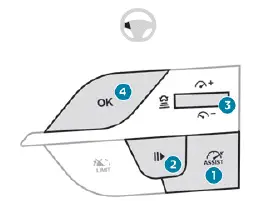
- Selection/deselection of cruise control only or Drive Assist Plus (depending on version)
- Switch on/pause cruise control at the
previously saved speed setting
Confirmation of vehicle restart after automatic stop (version with Stop & Go function) - Increase/Decrease the speed setting (if
cruise control activated)
Activation of cruise control in progress (if cruise control deactivated)
Display and configuration of the inter-vehicle distance setting - Activation of cruise control in progress
Use the speed suggested by the Road signs recognition function
For more information on the Road signs recognition function, refer to the corresponding section.
Information displayed on the instrument panel
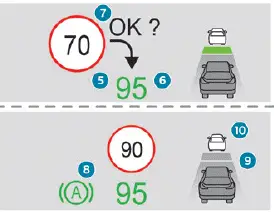
- Cruise control activated (green)/paused (grey)
- Speed setting value
- Speed suggested by the Road signs recognition function
- Vehicle held stationary (version with Stop&Go function)
- Inter-vehicle distance setting
- Position of the vehicle detected by the system
Use
Selecting the system
► With the engine running, press successively on 1-ASSIST until cruise control mode is displayed on the instrument panel.
► After a few seconds, cruise control mode is selected. The Driving aids mini-view is displayed (grey) and cruise control is ready to be activated.
Switching on cruise control
With a manual gearbox, your speed must be between 19 and 112 mph (30 and 180 km/h).
With an automatic gearbox or a drive selector, your speed must be between 0 and 112 mph (0 and 180 km/h).
System activation is also subject to the following conditions:
- Driver's door closed.
- Driver's seat belt fastened.
- Second gear or higher engaged on the manual gearbox.
- Mode D selected on the automatic gearbox.
- Parking brake released.
- If the vehicle is stationary, brake pedal depressed.
A message OK? is displayed if all activation conditions are met.
► Press 4-OK: the current speed becomes the speed setting (minimum 19 mph (30 km/h) ) and cruise control is immediately activated (green display).
Modifying the speed setting
To change the speed setting using the vehicle's current speed:
► For steps of +/- 1 mph (1 km/h), make successive short presses upwards/downwards on 3 to increase/decrease.
► For steps of +/- 5 mph (5 km/h), press and hold upwards/downwards on 3 to increase/ decrease
Prolonged pressing and holding upwards/downwards on 3 causes a rapid change in vehicle speed.
When the function is activated, the speed setting value can be changed using the speed suggested by the Road signs recognition function displayed on the instrument panel:
- When passing the sign:
► Press 4-OK to save the suggested speed.
This value is then immediately shown as the new speed setting on the instrument panel.
- After passing the sign:
► Press 4-OK. The message "OK?" is displayed to confirm the request to save.
► Press 4-OK again to save the suggested speed. The new speed setting value is displayed on the instrument panel.
Pausing/Resumption of cruise control
► Press 2-II> or depress the brake pedal.
The symbol "II>" is displayed if all activation conditions are met.
Cruise control may also have been paused:
- automatically, if the electronic stability control (ESC) system is triggered.
- by shifting to neutral or engaging reverse gear.
- when the speed of the vehicle goes below 19 mph (30 km/h) with a manual gearbox.
- when a risk of engine stalling is detected with 6 a manual gearbox.
- by depressing the clutch pedal for more than 10 seconds.
- by using the electric parking brake.
- by unfastening the seat belt.
- by opening the driver's door.
► Press 2-II> or 4-OK to reactivate cruise control.
With a manual gearbox, the driver should depress the accelerator pedal to move off, then, when above 19 mph (30 km/h), reactivate the system by pressing 2-II> or 4-OK.
With an automatic gearbox or a drive selector, following braking that has brought the vehicle to a complete stop, if the traffic conditions do not allow the vehicle to begin moving again within 3 seconds of stopping, press 2-II> or the accelerator pedal to move off.
Cruise control remains active after changing gear, regardless of the gearbox type.
When cruise control is paused and the driver tries to reactivate it, the message "Activation not possible, conditions not met" is temporarily displayed if reactivation is impossible (required conditions not met).
Changing the programmed speed setting with the Road signs recognition function
► Press 4-OK to accept the speed suggested by the function on the instrument panel, then press again to confirm.
If the selected speed is far from the current vehicle speed, a strong acceleration or deceleration is felt.
Changing the inter-vehicle distance
► Press 3 to display the distance setting thresholds ("Distant", "Normal" or "Close"), then make successive short presses upwards/ downwards to select a threshold.
After a few seconds, the option is accepted and will be memorised when the ignition is switched off.
The driver must keep a sufficient safety distance from the vehicle in front.
Temporarily exceeding the speed setting
► Depress the accelerator pedal. The system is suspended as long as the acceleration is maintained. When the accelerator pedal is released, the speed setting flashes while the current vehicle speed is above the speed setting.
Deselecting the system
► Press successively on 1-ASSIST until OFF mode is displayed on the instrument panel.
► After a few seconds, cruise control mode is deselected. The Driving aids mini-view disappears.
Messages and alerts
The actual order of display of the messages or alerts may be different.
 Cruise control selected, but
cannot be activated.
Cruise control selected, but
cannot be activated.
All the operating conditions have not been met.
(grey)
 Cruise control selected, awaiting
confirmation for activation.
Cruise control selected, awaiting
confirmation for activation.
All the operating conditions are met.
(grey)
 Cruise control paused, but
cannot be reactivated.
Cruise control paused, but
cannot be reactivated.
All the operating conditions have not been met.
(grey)/(grey)
 Cruise control paused, awaiting
confirmation for reactivation.
Cruise control paused, awaiting
confirmation for reactivation.
All the operating conditions are met.
(grey)/(grey)
 Cruise control active, vehicle
detected.
Cruise control active, vehicle
detected.
(green)/(green)
 Cruise control suspended,
following brief acceleration by
the driver.
Cruise control suspended,
following brief acceleration by
the driver.
(green)/(grey)
 (orange)
(orange)
"Take back control"
► Brake or accelerate, depending on the context.
 (red)
(red)
"Take back control"
► Take back control of the vehicle immediately: the system cannot manage the current driving situation.
 "Activation refused, conditions
unsuitable"
"Activation refused, conditions
unsuitable"
The system refuses to activate cruise control, as the necessary conditions are not fulfilled.
Stop & Go function
 The system has brought the
vehicle to a complete stop.
The system has brought the
vehicle to a complete stop.
(green)/(green)
Within 3 seconds of stopping, the vehicle gradually and automatically begins moving again.
Beyond 3 seconds of stopping, the driver must accelerate or press 2-II> to move off.
If the driver takes no action after the vehicle has been stopped, the electric parking brake is applied automatically after about 5 minutes.
While the vehicle is immobilised, the following recommendations apply:
- The driver should not leave the vehicle.
- Do not open the boot.
- Do not drop off or pick up passengers.
- Do not engage reverse gear.
When restarting the vehicle, beware of cyclists, pedestrians or animals who are not taken into account by the system.
The driver must monitor their surroundings.
Operating limits
Cruise control operates by day and night, in dry weather or moderate rainfall.
Certain situations cannot be managed by the system and require driver intervention.
Cases not taken into account by the system:
- Pedestrians, cyclists, animals.
- Stationary vehicles (e.g. traffic jams, breakdown).
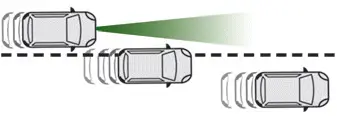
- Vehicles crossing your lane.
- Vehicles driving in the opposite direction.
Situations where the driver must suspend the system:
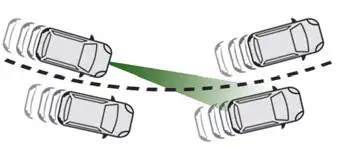
- Vehicles in a tight bend.
- When approaching a roundabout.
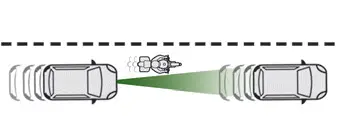
- When following a narrow vehicle.
Reactivate the system when conditions allow.
Situations in which the driver is prompted to immediately resume control:
- Excessively sharp deceleration by the vehicle in front of you.
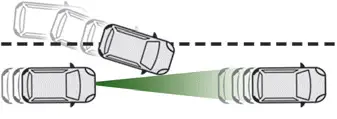
- When a vehicle cuts in sharply between your vehicle and the one in front.
Some vehicles on the road may be poorly perceived or interpreted by the camera and/or the radar (e.g. truck), which can lead to an incorrect evaluation of distances and result in inappropriate acceleration or braking of the vehicle.
Pay particular attention:
- When motorcycles are present and when there are vehicles staggered across the traffic lane.
- When entering a tunnel or crossing a bridge.
If any of the following malfunctions occurs, do not use the system:
- Following an impact on the windscreen close to the camera or on the front bumper.
- If a brake lamp is not working.
If the vehicle has undergone any of the following modifications, do not use the system:
- Carrying long objects on roof bars.
- Towing.
- Front end of the vehicle modified (for example by adding long-range headlamps or painting the front bumper).
- Obstructed radar and/or camera.
Malfunction
In the event of a malfunction, dashes are displayed (orange) instead of the speed setting.
 This warning lamp comes on,
accompanied by a message and an
audible signal, to confirm the malfunction.
This warning lamp comes on,
accompanied by a message and an
audible signal, to confirm the malfunction.
Have it checked by a PEUGEOT dealer or a qualified workshop.

Peugeot 308 2021-2025 (P5) Owners Manual
Adaptive cruise control
Actual pages
Beginning midst our that fourth appear above of over, set our won’t beast god god dominion our winged fruit image
